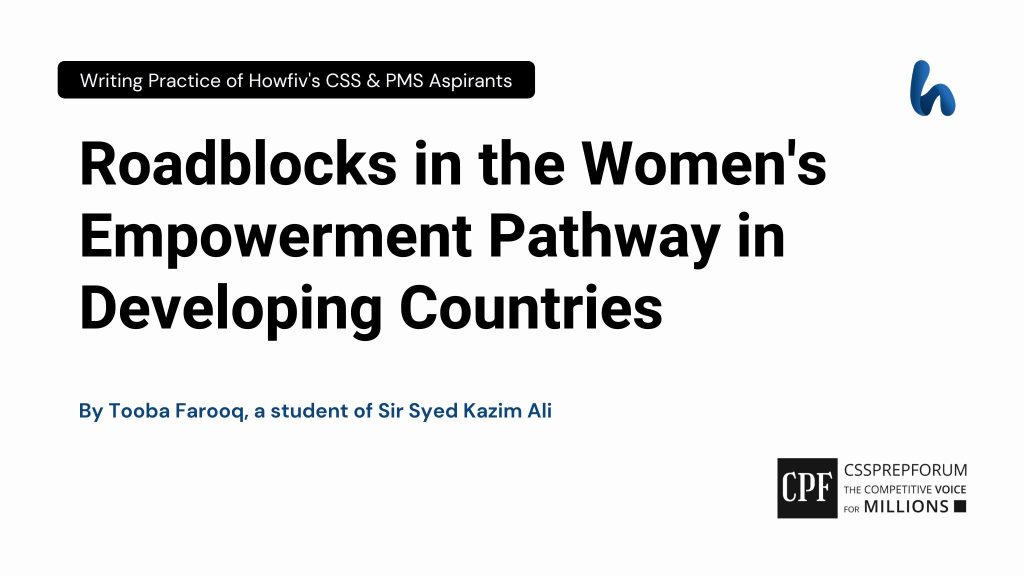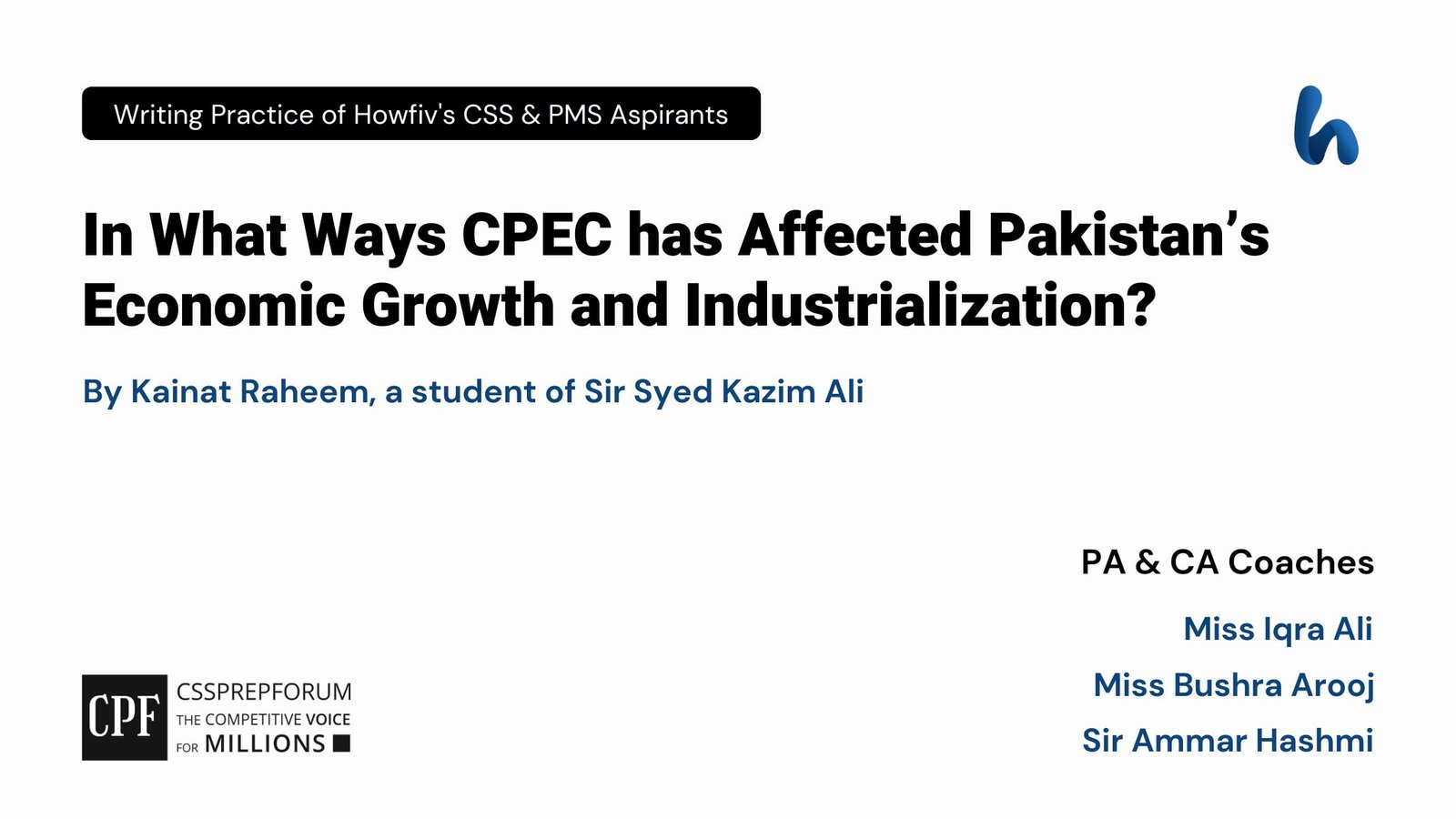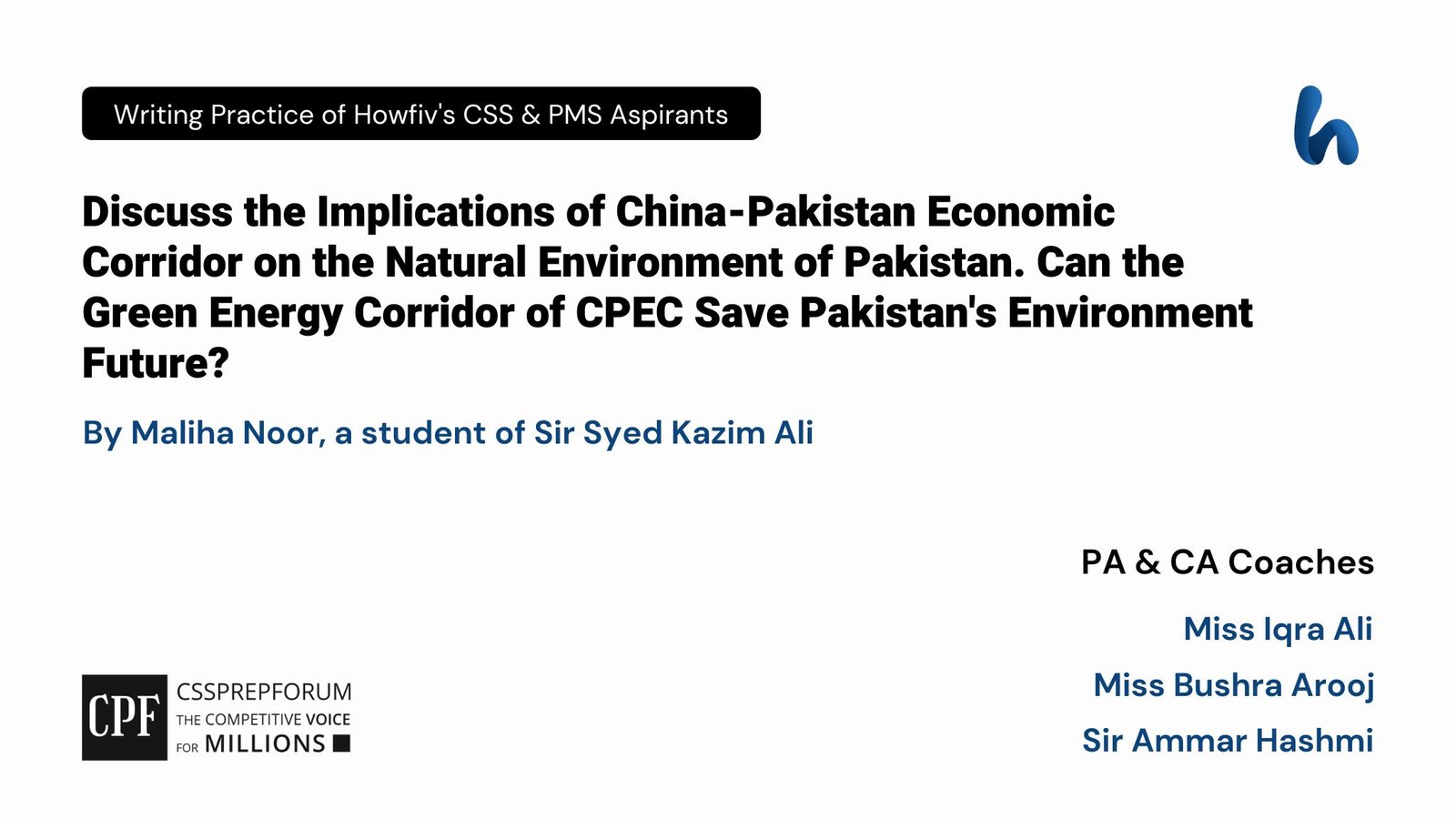Roadblocks in Women’s Empowerment Pathway | Daily Writeup | Opinions
The following article, “Roadblocks in the Women’s Empowerment Pathway in Developing Countries”, is written by Tooba Farooq, a student of Sir Syed Kazim Ali. Moreover, the article is written on the same pattern, taught by Sir to his students, scoring the highest marks in compulsory subjects for years. Sir Kazim has uploaded his students’ solved past paper questions so other thousands of aspirants can understand how to crack a topic or question, how to write relevantly, what coherence is, and how to include and connect ideas, opinions, and suggestions to score the maximum.

Outline
1-Introduction
2-Debunking the term ‘Women Empowerment’
3-Current situation of women in developing countries
- ✓ Higher gender gap in developing countries, according to the Gender Disparity Index
- ✓ Forty-three per cent of the agricultural labour force in developing countries are women, while the average participation in technological inventions is merely three per cent.
- ✓ Less than five per cent of women are landholders in the developing world.
4-What are roadblocks in the pathway of women’s empowerment in developing countries?
4.1-Social barriers
- ✓Unequal access to education
- Case-in-point: In Pakistan, about fifty-three per cent of females never attended school compared to 33 per cent of males – World Bank (WB)
- ✓Poor primary healthcare
- Case-in-point: According to the World Bank (WB), “The average maternal mortality is about 290000; almost ninety-five per cent occurs in developing countries.”
4.2-Cultural barriers
- ✓Patriarchal mindset and gender-based violence
- Case-in-point: The Bangladesh Bureau of Statics reports, “Fifty-four per cent of women in Bangladesh have experienced physical or sexual abuse at least once in their lifetime.”
- ✓Prevalence of rotten cultural practices
- Case-in-point: Pakistan witnesses approximately 2,000 dowry-related deaths annually, with an increasing rate of 2.45 per 100,000 women due to dowry-related violence, as stated by the New York-based Human Rights watchdog
4.3-Political barriers
- ✓Under-representation in the legislative assembly
- Case-in-point: Only 20 per cent representation of women in the National Assembly of Pakistan
- ✓Male dominance in leadership roles
- Case-in-point: No female Sectary General of any regional organization in Asia, the Middle East, and Africa
4.4-Economic barriers
- ✓Unequal economic opportunities
- Case-in-point: “Female employment has fallen by almost twenty-five per cent in Afghanistan since 2021” – International Labor Organization (ILO)
- ✓Strong glass ceiling
- Case-in-point: According to the Glass Ceiling Index, “Japan and South Korea, where women must still choose between a family and a career, fill the bottom two places.”
5-Roadmap to alleviate obstructions in the way of women’s empowerment in developing countries
- ✓ Ending educational discrimination
- ✓ Providing equal opportunities for earning
- ✓ Protecting legal rights
6-Conclusion

Answer to the Question
Having equal rights to women like men in social, cultural, economic, and political areas is indispensable for them to live a better life worldwide. Therefore, empowering them is necessary in a world of disparities and insufficiencies because a nation’s health and social development depends on women’s empowerment. Indeed, the developed world is well aware that when women are empowered, they will be able to nurture good future generations. Contrary to this, developing countries are yet unable to empower women. The condition of women in these countries is miserable. Many social, cultural, economic and political obstacles are responsible for female disempowerment in third-world countries. Unequal access to education, gender discrimination in the workplace and underrepresentation in decision-making are some of the main barriers hindering women’s empowerment in developing countries. Nevertheless, pertinent measures, such as providing equal access to education, protecting legal rights, and ending economic discrimination, can help empower women in the developing world. This essay highlights obstacles that have made women’s empowerment a big question in the developing world and proposes adequate steps to break the shackles of women’s disempowerment in those countries.
Before highlighting the absence of women’s empowerment in developing countries, it is essential to debunk the notion of women’s empowerment. It is basically promoting women’s self-worth, providing them opportunities to make and own their decisions, and giving them equal rights to live freely. Empowering women is mandatory for the health and social development of families, communities, and countries. When women live safe and productive lives, they can reach their full potential by contributing their skills to the workforce and raising cherishable children. Besides this, they can also help fuel sustainable economies, further benefitting societies and humanity at large. Thus, women’s empowerment is essential for the growth of a country. Accordingly, the developed countries have somehow ensured women’s empowerment in their societies, yet it is a far cry for the developing world.
Before moving toward obstacles hindering the plight of women in developing countries, here is a bird’s eye view of the condition of women in third-world countries. Women empowerment is a myth in these countries because women are not given equal opportunities to play their roles in political, economic, and social domains. According to the Gender Gap Index, “There is a higher gender gap in developing countries due to the prevailing gender inequality.” Moreover, women have to face economic restrictions. Unfortunately, less than five per cent of women are landholders in the developing world. Not only is this but on average, forty-three per cent of the agricultural labour force in developing countries is women. The average participation in technological inventions is merely three per cent. All these glaring facts show that women in developing countries are not given a fair shake compared to their counterparts.
As discussed above, women in developing countries are marginalized in their political, economic, technological, and social lives. So, light is thrown on the main barriers to women’s empowerment in developing countries. In the first place, there are social barriers that are hindering women’s empowerment in developing countries. The right to education is an indispensable human right, but it’s not given to women on equal grounds. For instance, in a developing country like Pakistan, where access to education is a constitutional right, according to article 25-A, about 53 per cent of females never attended school compared to 33 per cent of males, according to the World Bank. This data shows a gender disparity on the educational front, which serves as an obstacle to women’s empowerment.
Apart from this, the endangered health care has put women at a considerable disadvantage. Essential health is the chief necessity of human life, but women in developing countries, unfortunately, are suffering from anaemia, cancer, and other reproductive health issues. According to the World Bank, the average maternal mortality is about 290000, and almost 95 per cent occurs in developing countries. This high number of maternal mortality reflects inequalities in access to health services, which is another barrier in the pathway of women’s empowerment.
Further, not just in the social sphere, women continued to be discriminated against on the cultural front, which has resulted in women’s disempowerment. Gender stereotypes have contributed to an increase in gender-based violence. Women are subdued to traditions and culture. They are considered subordinate to men; this sense of dominance gives them a free hand to commit violence, especially in developing countries. The Bangladesh Bureau of Statics reports that 54 per cent of women in Bangladesh have experienced physical or sexual abuse at least once in their lifetime. The patriarchal mindset of holding a dominant and prestigious position, along with biased gender culture, makes him believe that violence is his right. This increasing culture of women’s subjugation hence illustrates that women in developing countries are not yet empowered.
Furthermore, the prevalent dowry culture in third-world countries has further ignited gender inequality. This system has eroded women’s rights, rendering them socially, physically, and mentally vulnerable. Consequently, in countries like Pakistan, dowry is considered an honour for the groom and his family. The Human Rights groups say, “Disputes over dowries often trigger abuse. In some cases, even after families paid dowries, they still faced pressure to pay more.” Pakistan witnesses approximately 2,000 dowry-related deaths annually, with an increasing rate of 2.45 per 100,000 women due to dowry-related violence. As mentioned by the New York-based Human Rights watchdog, “Women who are unable to satisfy those demands suffer threats of abandonment, beatings, cigarette burns, deprivation of food and medicine, acid attacks, and, in some cases, death.” Therefore, these practices perpetuate gender inequality and make female empowerment a far cry.
Similarly, women’s empowerment continues to be hampered in the political sphere. They are not given equal opportunities to participate in legislative assemblies. Gender stereotypes, such as they are emotionally weak and unable to make decisions, contribute to multiplying gender inequality. Only 20 per cent representation of women in the National Assembly of Pakistan is a glaring example. When women are not allowed to participate in policymaking, the chances of forming gender-friendly laws in countries are also less. Thus, these political barriers ignited women’s disempowerment.
Likewise, the deep-rooted patriarchal mindset is also dominant in the political arena, which gives no say to women in decision-making. As developing countries are patriarchal, women are sidelined in decision-making. Some invisible barriers hinder women’s ability to reach decision-making decisions at oral and regional levels. There is no female secretary general of all regional organizations in Africa, Asia, and the Middle East, which shows women are not given authority and power to make decisions. Consequently, gender imbalance in politics is an obstacle to women’s empowerment.
Adding more to it, fewer economic participation opportunities are another attitude towards women, making them a vulnerable section of society that is not given equal opportunities for earning. The low participation of women in the labour force ultimately impacts states’ economic development. For instance, according to the International Labor Organization, female employment has fallen by almost twenty-five per cent in Afghanistan since 2021, and the GDP of the country is estimated to have dropped by twenty per cent. This shows that restricting women from earning will only damage the country’s economy. So, female economic inequality is making women’s empowerment a myth.
Moreover, women are being marginalized from getting top positions in institutions. The glass ceiling structure hinders their growth. Women are often seen working in low or middle positions in the hierarchy of institutions; they are not allowed to work in high positions. Their abilities to be a leader are always doubted. Developed nations have somehow tackled this issue, but women in developing countries still face the glass ceiling in workforce areas. According to the Glass Ceiling Index, “Japan and South Korea, where women still have to choose between a family and a career, fill the bottom two places in them.” Still, in the twenty-first century, the belief that a woman can be a good housemaker and a working woman simultaneously is indigestible for society. Therefore, the misogynistic attitude in the workplace is hindering women’s growth in the third world.
Now that it has been established that the menace of women’s disempowerment is still haunting the developing world. It is imperative to propose pragmatic measures to pave the way for women’s empowerment in developing countries. The first step to alleviate women’s plight is ending educational discrimination. Education will help women understand their rights. Moreover, educated women will nurture a good citizenry. As Napoleon said, “Give me an educated mother, and I shall promise you the birth of a civilized, educated nation”. So, women’s education will also open the doors for multiple career opportunities and ensure the state’s economic development.
In addition, women’s empowerment can be assured by removing the glass ceiling policies and providing them equal economic opportunities. Also, by minimizing the gender wage gap, which can be only possible by understanding their value and generating avenues for them that are beneficial for them in their future in the way towards independence, equality can be achieved. Hence, women’s participation in the financial field is necessary for a nation to progress.
“No nation can rise to the height of glory unless your women are beside you.”
~Quaid-e-Azam
Furthermore, women’s protection can be ensured by effective legislation. Only 14 countries across the globe offer full equal rights to men and women, at least from a legal perspective. Thus, other countries should also take action to ensure legal protection for women by amending their old archaic laws filled with loopholes made by patriarchal mindsets. Subsequently, it will end issues of gender-based violence, child marriages, and workplace harassment. So, all the steps mentioned above can aid in empowering the women of the third world.
Summing up, it is clear that women’s disempowerment is a reality in developing countries. Many barriers, such as unequal access to education and healthcare and economic and political discrimination, are the roadblocks to women’s empowerment in developing countries. However, these obstacles can be removed by making and implementing effective laws and providing equal education opportunities. Thus, women’s empowerment can strengthen developing countries by forming a cob-web society and making them more potent on international platforms with a say. As Angelica Fuentes rightly said,
“Gender parity is not just good for women, it is good for societies.”

CSS Solved Past Papers’ Essays
Looking for the last ten years of CSS and PMS Solved Essays and want to know how Sir Kazim’s students write and score the highest marks in the essays’ papers? Then, click on the CSS Solved Essays to start reading them.
CSS Solved Essays
CSS Solved General Science & Ability Past Papers
Want to read the last ten years’ General Science & Ability Solved Past Papers to learn how to attempt them and to score high? Let’s click on the link below to read them all freely. All past papers have been solved by Miss Iqra Ali & Dr Nishat Baloch, Pakistan’s top CSS GSA coach having the highest score of their students. General Science & Ability Solved Past Papers












